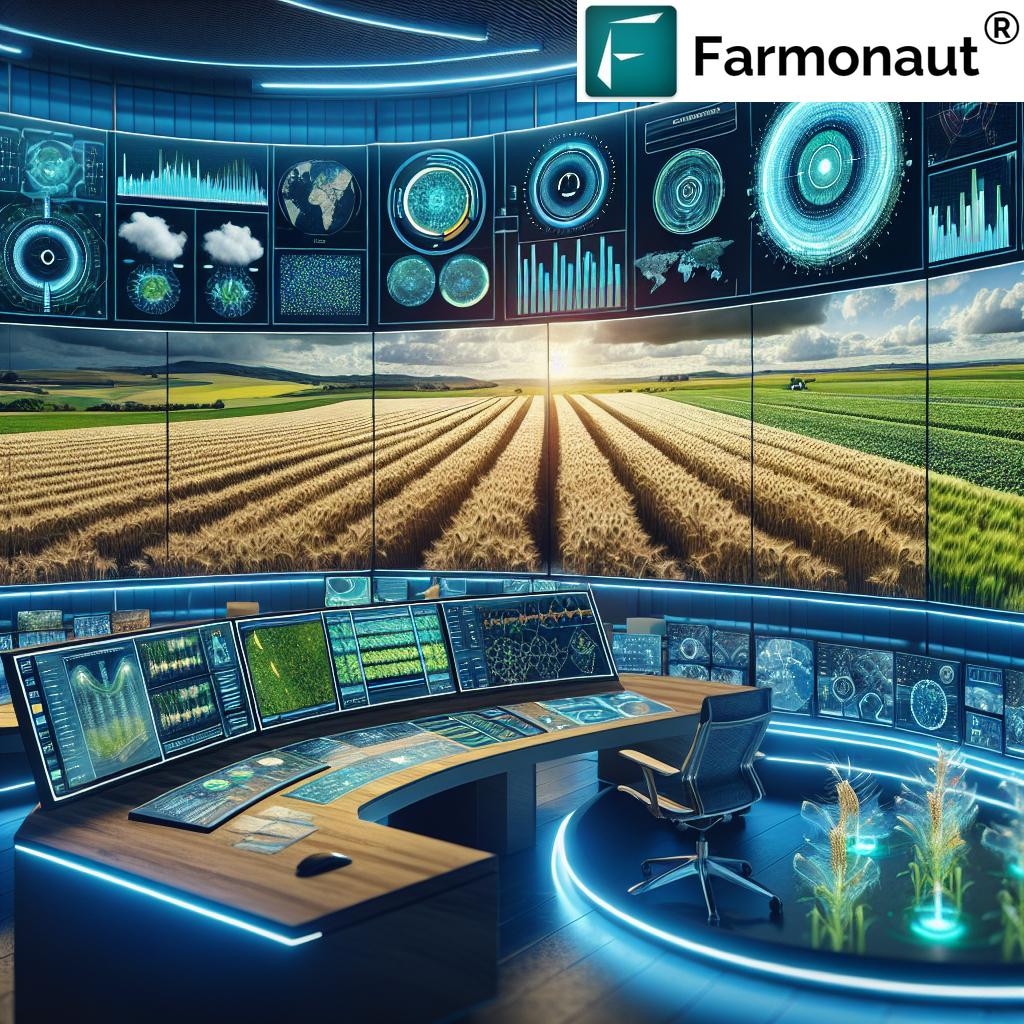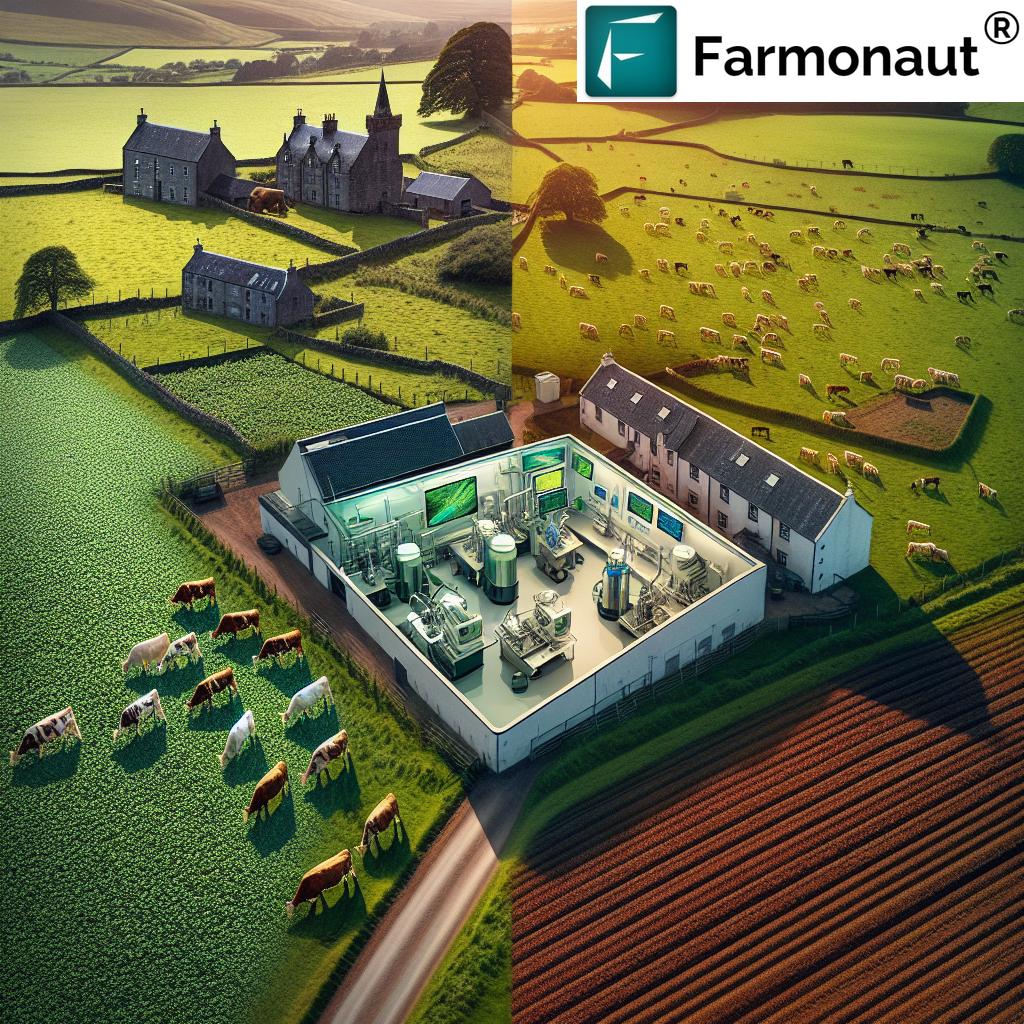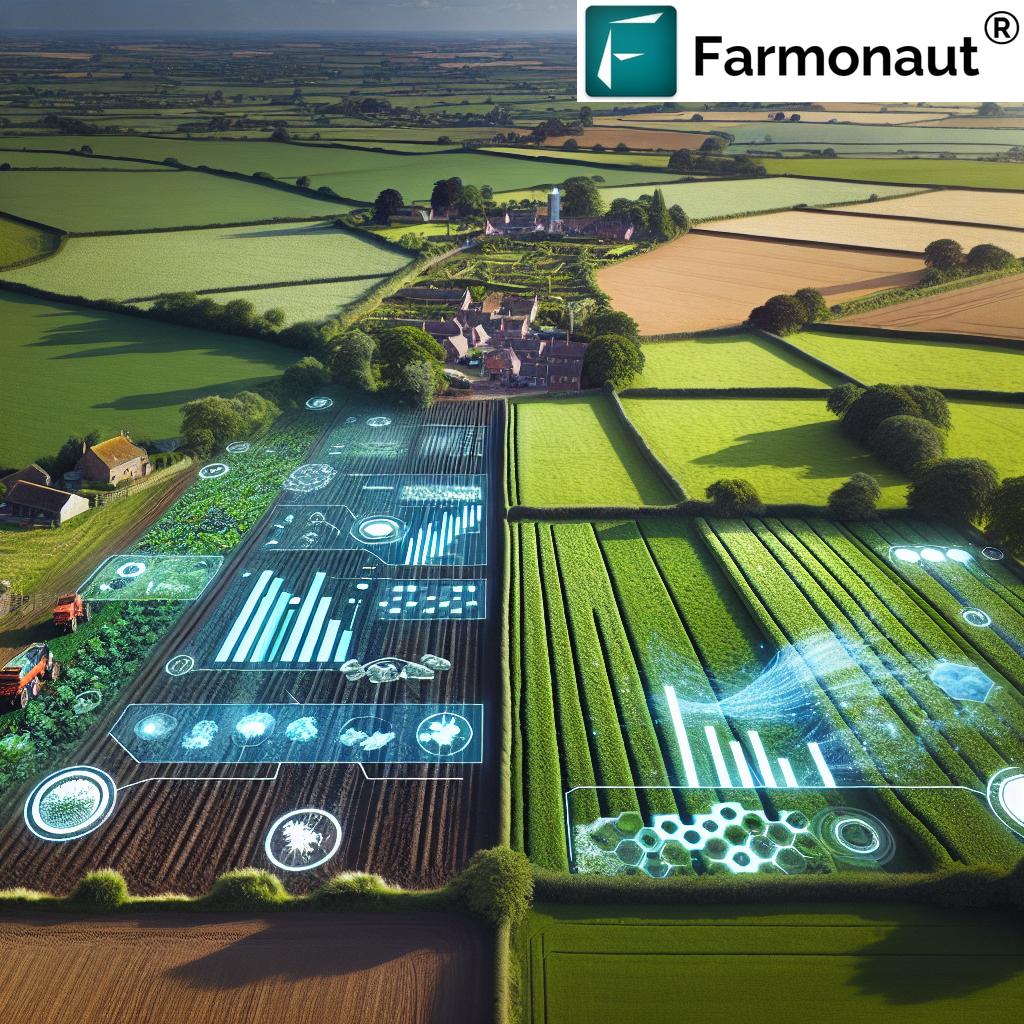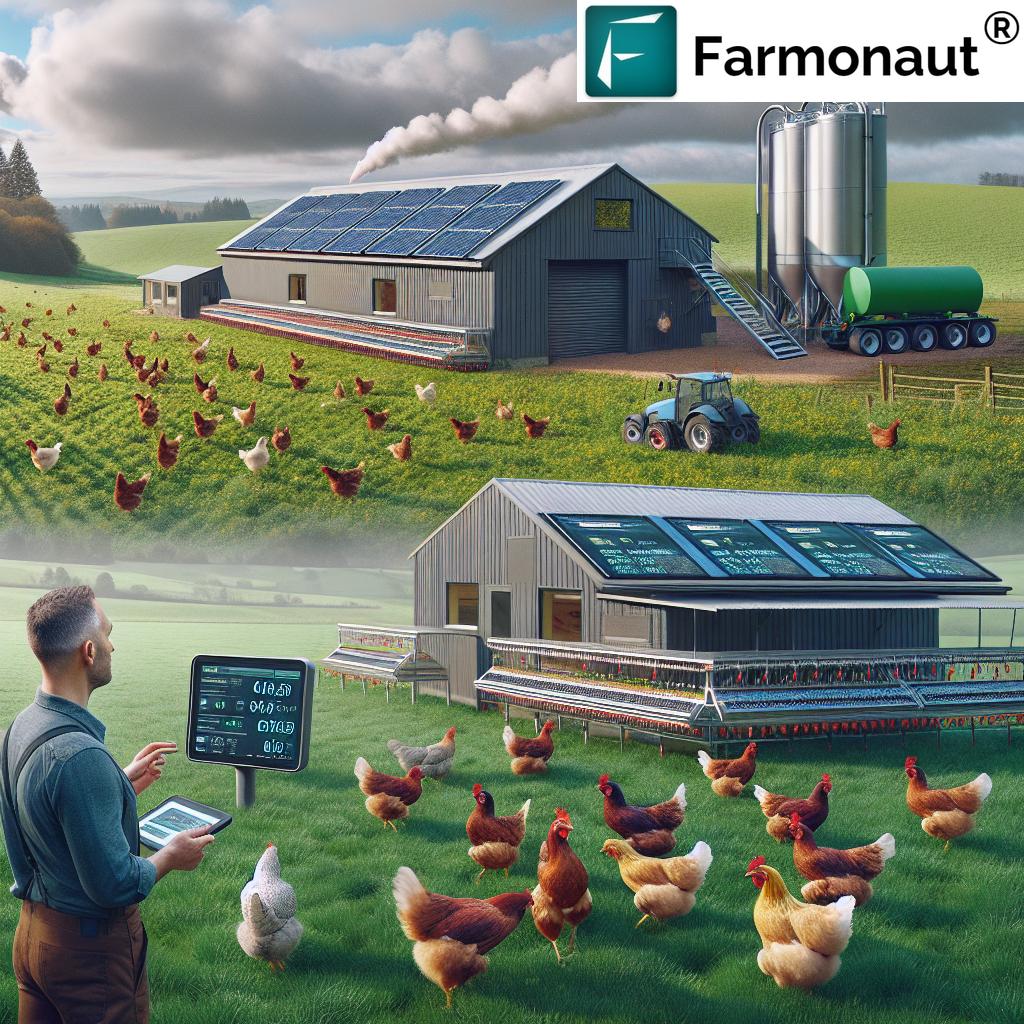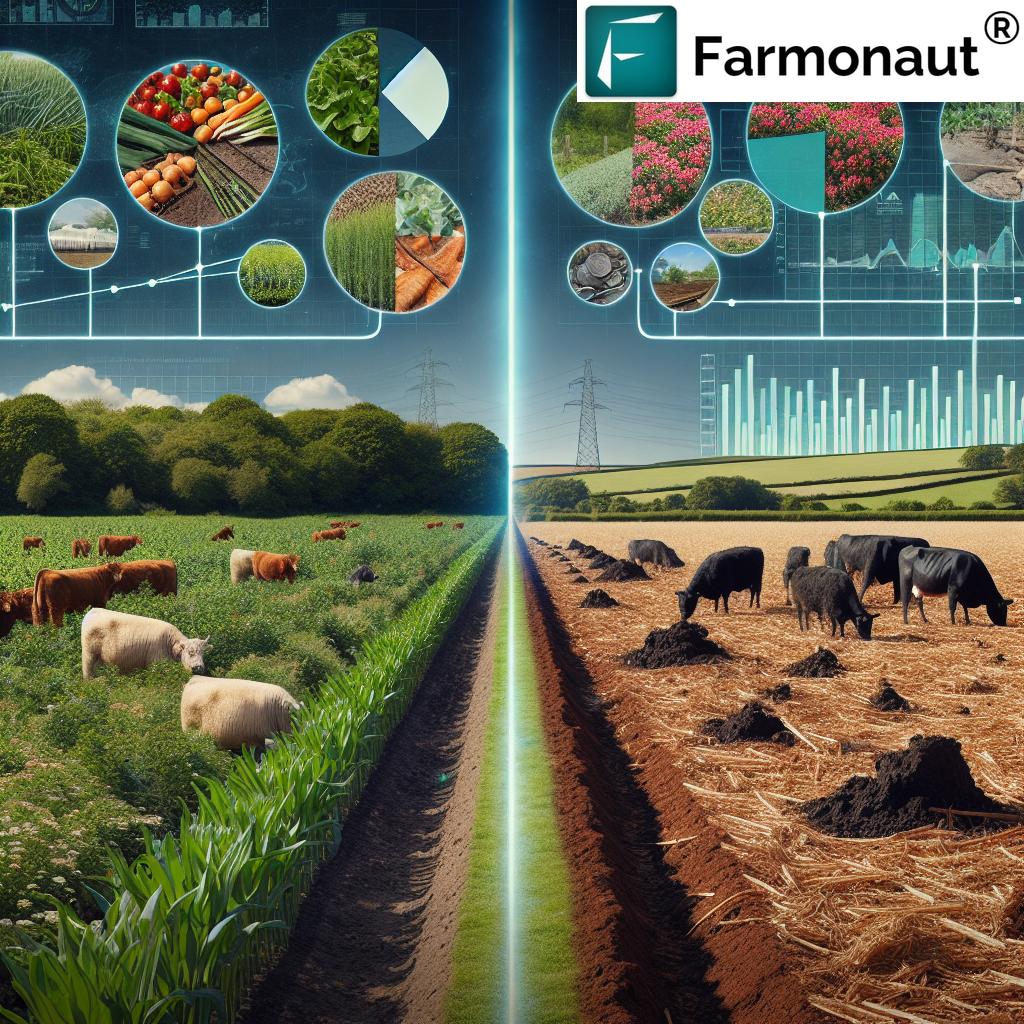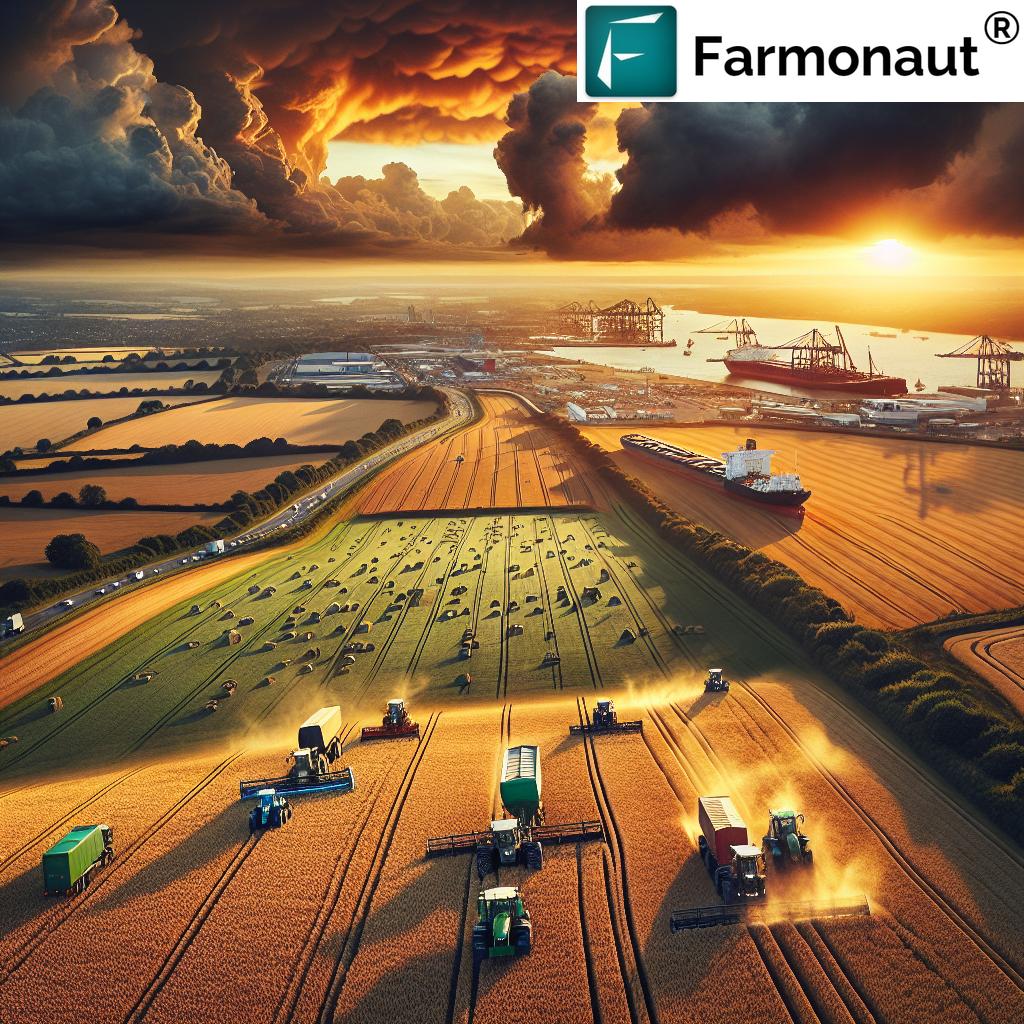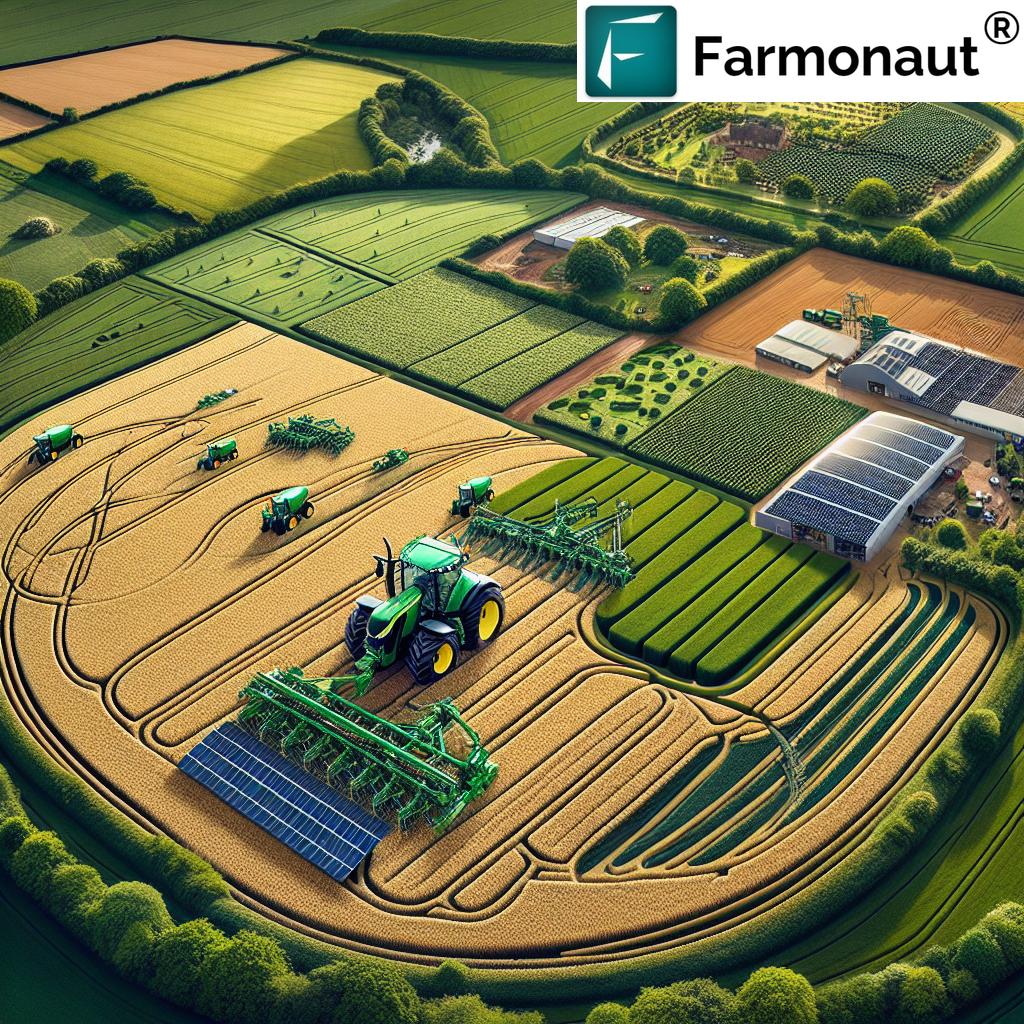Revolutionizing English Farms: How Precision Agriculture Technology Boosts Crop Yields and Sustainability
“Precision agriculture technology has increased crop yields by up to 15% on English farms implementing these solutions.”
Welcome to a comprehensive exploration of how precision agriculture technology and smart farming solutions are transforming the landscape of rural farms across England and Wales. In this blog post, we’ll delve into the cutting-edge advancements that are reshaping the agricultural sector, boosting crop yields, and promoting sustainability in ways that were once thought impossible.
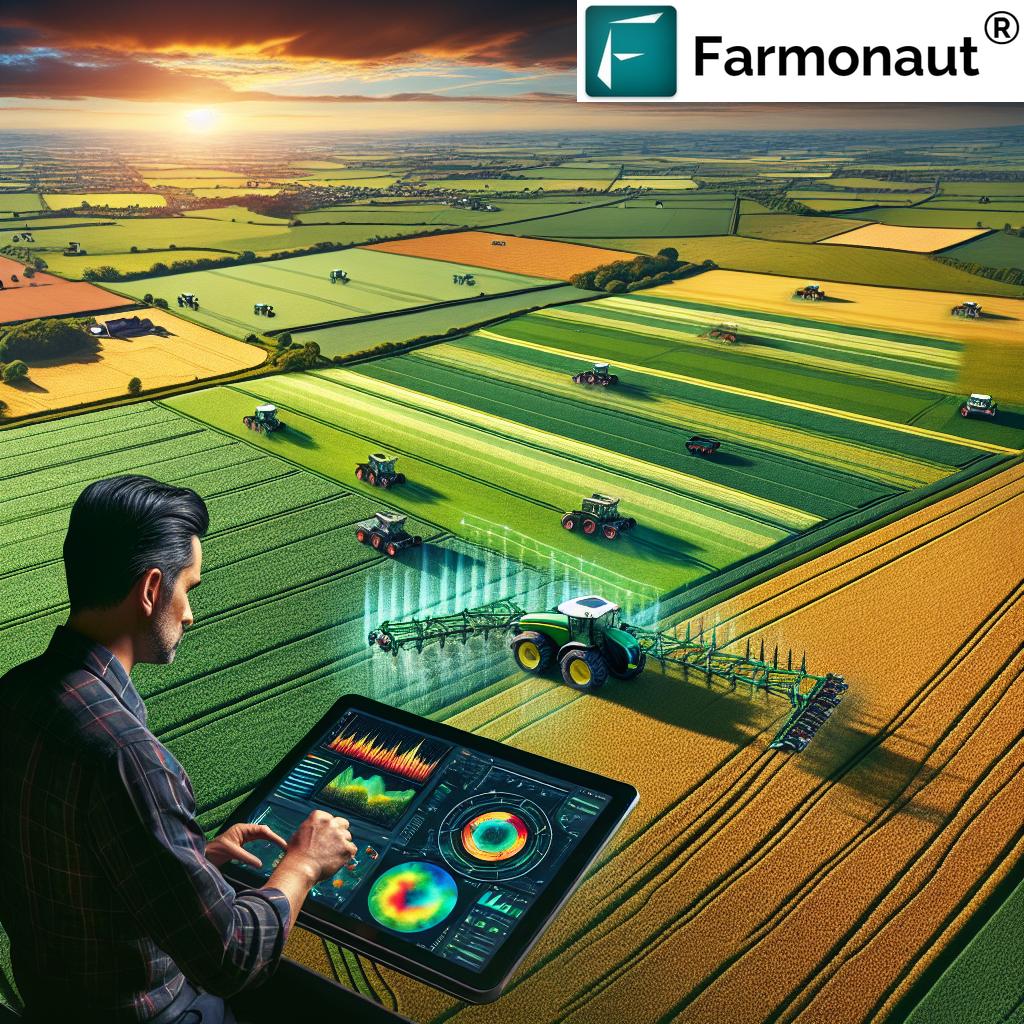
As we navigate through the intricacies of modern farming, we’ll explore how agricultural GIS mapping, farm equipment automation, and innovative approaches to irrigation system optimization are revolutionizing crop management and elevating farm productivity to unprecedented levels. From the rolling grasslands of Wales to the arable lands of East Anglia, these technologies are making a significant impact on farms of all sizes and types.
The Rise of Precision Agriculture in England and Wales
Precision agriculture has emerged as a game-changer for farmers across England and Wales. This technology-driven approach to farming uses data to make informed decisions about every aspect of crop production, from seeding to harvest. Let’s break down some of the key components:
- Satellite Imaging: Advanced satellite technology provides farmers with detailed views of their fields, allowing them to identify areas of concern and optimize crop management strategies.
- GPS-Guided Machinery: Tractors and other farm equipment equipped with GPS technology can operate with centimeter-level precision, reducing overlap and improving efficiency.
- Soil Sensors: These devices measure various soil properties, including moisture content, nutrient levels, and pH, enabling farmers to tailor their inputs precisely to each area of their fields.
- Drones: Agricultural drones are increasingly used for crop scouting, providing high-resolution images that can detect early signs of pest infestations or crop diseases.
The adoption of these technologies has been remarkable. According to recent surveys, over 60% of arable farms in England and Wales now use GIS mapping for improved crop management and sustainability. This rapid uptake is a testament to the tangible benefits that precision agriculture brings to the table.
Sustainable Crop Management: A New Era for English Farms
Sustainable crop management is at the heart of precision agriculture’s impact on English farms. By leveraging advanced technologies, farmers can now implement practices that not only boost yields but also promote long-term environmental health. Here’s how:
- Variable Rate Application: This technique allows farmers to apply fertilizers, pesticides, and water at variable rates across their fields, ensuring that each area receives exactly what it needs.
- Precision Irrigation: Smart irrigation systems use soil moisture sensors and weather data to deliver water precisely where and when it’s needed, reducing water waste and improving crop health.
- Crop Rotation Optimization: GIS mapping helps farmers plan more effective crop rotations, improving soil health and reducing the need for chemical inputs.
- Integrated Pest Management: By combining satellite imagery, ground-level sensors, and AI-powered analysis, farmers can detect and address pest issues early, minimizing the use of pesticides.
These practices not only enhance productivity but also contribute significantly to the sustainability of English agriculture. By reducing input waste and minimizing environmental impact, precision agriculture is helping farmers meet the growing demand for food while preserving the land for future generations.
The Role of Agricultural GIS Mapping in Modern Farming
Agricultural GIS (Geographic Information System) mapping has become an indispensable tool for farmers across England and Wales. This technology allows for the creation of detailed, layered maps of farmland, incorporating data on soil types, crop health, yield history, and more. Here’s how GIS mapping is revolutionizing farm management:
- Field Variability Analysis: GIS maps reveal variations in soil properties, moisture levels, and crop performance across fields, enabling targeted interventions.
- Yield Mapping: By overlaying yield data with other field information, farmers can identify areas of high and low productivity and adjust their strategies accordingly.
- Resource Allocation: GIS helps optimize the use of resources like water, fertilizers, and pesticides by identifying areas that need more or less of each input.
- Decision Support: The comprehensive view provided by GIS mapping supports better decision-making in all aspects of farm management, from crop selection to harvest timing.
The impact of GIS mapping on English farms has been profound. Farmers report improved efficiency, reduced costs, and more sustainable practices as a result of implementing this technology. As GIS systems become more sophisticated and accessible, their role in agriculture is only expected to grow.
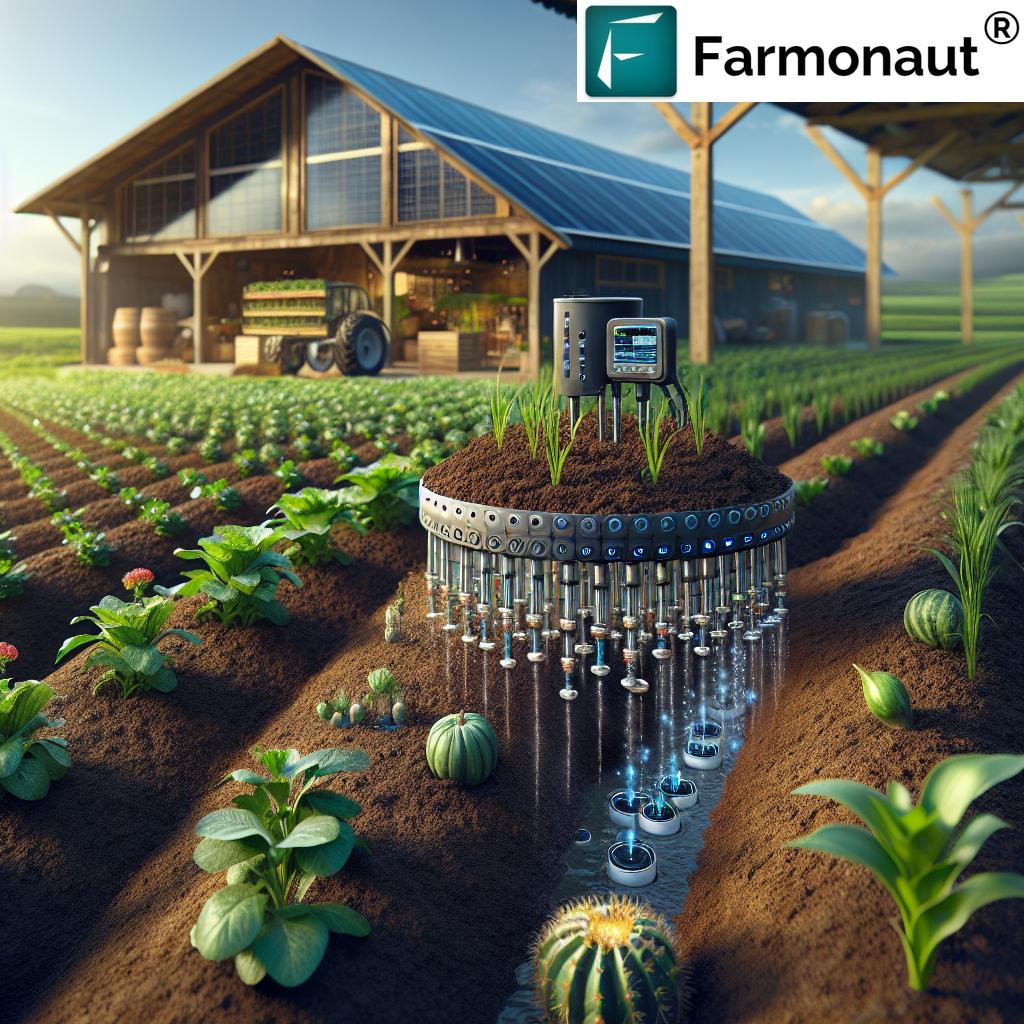
Farm Equipment Automation: The Future of Farming
Automation is rapidly transforming farm operations across England and Wales. From self-driving tractors to robotic milking systems, automated equipment is enhancing efficiency and productivity in various aspects of farming. Here are some key areas where automation is making a significant impact:
- Autonomous Tractors: These vehicles can operate without human intervention, following pre-programmed routes and adjusting their operations based on real-time data.
- Robotic Harvesters: Particularly useful for labor-intensive crops like fruits and vegetables, robotic harvesters can work around the clock, increasing efficiency and reducing labor costs.
- Automated Irrigation Systems: These systems use sensors and weather data to optimize water usage, ensuring crops receive the right amount of water at the right time.
- Livestock Management Systems: Automated feeding systems, robotic milkers, and smart tags for monitoring animal health are revolutionizing livestock farming.
The adoption of automated farm equipment is not just about efficiency; it’s also addressing labor shortages in rural areas and allowing farmers to focus on strategic decision-making rather than routine tasks. As these technologies continue to evolve, we can expect to see even greater levels of automation on English farms in the coming years.
“Over 60% of arable farms in England and Wales now use GIS mapping for improved crop management and sustainability.”
Organic Farming Practices Enhanced by Technology
Organic farming in England and Wales is experiencing a renaissance, thanks to the integration of precision agriculture technologies. While organic farming emphasizes natural processes and minimizes synthetic inputs, modern technology is helping organic farmers improve yields and sustainability. Here’s how:
- Precision Weed Management: Advanced imaging and AI-powered systems help identify and target weeds, allowing for precise mechanical removal without herbicides.
- Biological Pest Control: Drones and sensor networks monitor pest populations, enabling timely and targeted release of beneficial insects.
- Soil Health Monitoring: Advanced sensors and analytics tools provide detailed insights into soil health, helping organic farmers maintain optimal growing conditions naturally.
- Crop Rotation Planning: AI-powered systems analyze historical data and current field conditions to suggest optimal crop rotations that maximize soil health and natural pest control.
These technological advancements are helping organic farmers overcome some of the traditional challenges associated with organic production, such as weed control and pest management. As a result, organic farms in England and Wales are becoming more productive and economically viable, contributing to the growth of sustainable agriculture in the region.
Irrigation System Optimization: Maximizing Water Efficiency
Water management is a critical aspect of farming, especially in regions of England and Wales that experience periodic droughts. Precision agriculture technologies are revolutionizing irrigation practices, leading to significant improvements in water use efficiency. Here’s how:
- Smart Sprinkler Systems: These systems use weather data and soil moisture sensors to adjust watering schedules automatically, ensuring optimal water usage.
- Drip Irrigation: Precision drip irrigation systems deliver water directly to plant roots, minimizing evaporation and runoff.
- Variable Rate Irrigation: Using GIS mapping and soil moisture data, these systems apply different amounts of water to different parts of the field based on specific needs.
- Water Recycling Systems: Advanced filtration and treatment technologies allow for the safe reuse of water in agricultural operations, reducing overall water consumption.
By implementing these advanced irrigation technologies, English farms are not only conserving water but also improving crop yields and quality. This is particularly important as climate change continues to impact weather patterns and water availability across the region.
Crop Yield Forecasting: Precision in Planning
Accurate crop yield forecasting is essential for effective farm management, and precision agriculture technologies are taking this to new levels of accuracy. Here’s how advanced forecasting is benefiting English farms:
- Satellite Imagery Analysis: Regular satellite images provide insights into crop health and potential yield, allowing for early interventions if needed.
- Machine Learning Models: These models analyze historical yield data, current crop conditions, and weather forecasts to predict yields with increasing accuracy.
- IoT Sensors: Networks of sensors throughout fields provide real-time data on soil and crop conditions, feeding into yield prediction models.
- Drone-Based Assessment: Drones equipped with multispectral cameras can assess crop health and predict yields at a granular level.
Accurate yield forecasting allows farmers to make informed decisions about resource allocation, harvest timing, and market planning. This precision in planning is helping English farms become more resilient and profitable in an increasingly competitive global market.
Agricultural Drone Technology: Eyes in the Sky
Drones have rapidly become an indispensable tool in modern agriculture, offering farmers in England and Wales a bird’s-eye view of their operations. Here’s how drone technology is revolutionizing farming practices:
- Crop Scouting: Drones equipped with high-resolution cameras can quickly survey large areas, identifying issues like pest infestations or irrigation problems.
- Precision Spraying: Some drones can carry and deploy pesticides or fertilizers, allowing for targeted application in hard-to-reach areas.
- 3D Mapping: Drones can create detailed 3D maps of farmland, providing valuable data for precision planting and field management.
- Livestock Monitoring: On larger farms, drones help monitor livestock health and movements, improving herd management.
The adoption of drone technology is helping English farmers reduce labor costs, improve crop health, and make more informed decisions about their operations. As drone technology continues to advance, we can expect to see even more innovative applications in agriculture.
Soil Health Monitoring: The Foundation of Sustainable Agriculture
Maintaining healthy soil is crucial for sustainable agriculture, and precision farming technologies are providing farmers with unprecedented insights into soil health. Here’s how advanced soil monitoring is benefiting English farms:
- Real-Time Soil Sensors: These devices provide continuous data on soil moisture, temperature, and nutrient levels.
- Spectral Analysis: Advanced imaging techniques can analyze soil composition without the need for physical samples.
- Microbial Activity Monitoring: New technologies can assess soil microbial health, a key indicator of overall soil quality.
- Erosion Detection: Satellite and drone imagery can track changes in soil structure and identify areas at risk of erosion.
By closely monitoring soil health, farmers can make more informed decisions about crop rotation, fertilizer application, and tillage practices. This not only improves crop yields but also ensures the long-term sustainability of England’s agricultural lands.
Diversification and Sustainability in English Agriculture
Diversification is becoming increasingly important for English farms, both as a risk management strategy and as a way to promote sustainability. Precision agriculture technologies are supporting this trend in several ways:
- Agroforestry: GIS mapping and precision planting technologies are helping farmers integrate trees into their agricultural systems, improving biodiversity and creating new income streams.
- Beekeeping: Smart hive monitoring systems are making it easier for farmers to add beekeeping to their operations, supporting pollination and producing honey.
- Renewable Energy: Precision mapping tools help farmers identify optimal locations for wind turbines or solar panels, allowing them to diversify into energy production.
- Precision Livestock Farming: Advanced monitoring systems are improving efficiency in dairy, poultry, and other livestock operations, making these endeavors more viable for diversifying farms.
By embracing diversification supported by precision technologies, English farms are becoming more resilient to market fluctuations and climate challenges while contributing to a more sustainable agricultural sector.
The Role of Farmonaut in Revolutionizing English Agriculture
As we explore the transformative impact of precision agriculture on English farms, it’s important to highlight the role of innovative companies like Farmonaut in driving this revolution. Farmonaut offers advanced, satellite-based farm management solutions that are making precision agriculture more accessible and affordable for farmers across England and Wales.
Key features of Farmonaut’s platform include:
- Satellite-Based Crop Health Monitoring: Providing real-time insights into vegetation health and soil moisture levels.
- AI-Powered Advisory System: Delivering personalized farm management strategies based on satellite data and expert knowledge.
- Blockchain-Based Traceability: Ensuring transparency and security in agricultural supply chains.
- Resource Management Tools: Helping farmers optimize their use of inputs and machinery.
Farmonaut’s technologies are particularly valuable for English farmers looking to implement precision agriculture practices without significant upfront investments in hardware. By leveraging satellite technology and AI, Farmonaut is democratizing access to advanced farming techniques, enabling farms of all sizes to benefit from precision agriculture.
For more information on how Farmonaut can help revolutionize your farming operations, visit their web application or explore their API services.
The Impact of Precision Agriculture on English Farms: A Comparative Analysis
| Farm Operation | Traditional Method | Precision Agriculture Method | Estimated Improvement |
|---|---|---|---|
| Crop Yield | Uniform planting | Variable-rate seeding based on soil data | 15-20% increase in yield |
| Water Usage | Scheduled irrigation | Sensor-based precision irrigation | 30-50% reduction in water use |
| Fertilizer Application | Blanket application | Variable-rate application based on soil needs | 20-30% reduction in fertilizer use |
| Pest Management | Scheduled spraying | Targeted application based on real-time monitoring | 40-60% reduction in pesticide use |
| Overall Sustainability | Generic best practices | Data-driven, site-specific management | 25-35% improvement in resource efficiency |
The Future of English Agriculture: Challenges and Opportunities
As we look to the future of agriculture in England and Wales, it’s clear that precision farming technologies will play an increasingly important role. However, this transformation also brings challenges that need to be addressed:
- Digital Skills Gap: There’s a growing need for farmers and farm workers to develop digital skills to fully leverage precision agriculture technologies.
- Data Management: The vast amount of data generated by precision farming tools requires robust management systems and data analysis skills.
- Initial Investment Costs: While precision agriculture can lead to long-term savings, the initial investment can be a barrier for some farmers.
- Rural Connectivity: Reliable broadband and mobile connectivity in rural areas is crucial for the effective implementation of many precision farming technologies.
Despite these challenges, the opportunities presented by precision agriculture are immense. As technologies continue to evolve and become more accessible, we can expect to see:
- Further increases in crop yields and quality
- Improved resource efficiency and sustainability
- Greater resilience to climate change impacts
- Enhanced traceability and food safety
- New opportunities for farm diversification and value-added production
The future of English agriculture is one of innovation, sustainability, and precision. By embracing these new technologies and approaches, farmers across England and Wales are not only securing their own futures but also contributing to a more sustainable and productive agricultural sector for generations to come.
Conclusion: Embracing the Precision Agriculture Revolution
As we’ve explored throughout this blog post, precision agriculture technology is revolutionizing farming practices across England and Wales. From satellite-based crop monitoring to AI-powered advisory systems, these innovations are helping farmers boost yields, reduce environmental impact, and create more sustainable agricultural systems.
The adoption of precision agriculture technologies is not just a trend; it’s a necessary evolution in farming practices to meet the challenges of the 21st century. By embracing these technologies, English farmers are positioning themselves at the forefront of global agriculture, ready to meet the demands of a growing population while preserving the land for future generations.
As we move forward, collaboration between farmers, technology providers like Farmonaut, researchers, and policymakers will be crucial to fully realize the potential of precision agriculture. By working together, we can ensure that English agriculture remains vibrant, productive, and sustainable for years to come.
To learn more about how you can implement precision agriculture technologies on your farm, explore Farmonaut’s solutions:
FAQs: Precision Agriculture in England and Wales
- What is precision agriculture?
Precision agriculture is a farming management concept that uses technology to observe, measure, and respond to variability in crops, optimizing resource use and improving yield. - How does GIS mapping benefit farmers?
GIS mapping allows farmers to create detailed maps of their fields, incorporating various data layers to make informed decisions about planting, fertilizing, and harvesting. - What role do drones play in precision agriculture?
Drones are used for crop scouting, creating 3D maps, precision spraying, and monitoring overall farm health from above. - How does precision agriculture contribute to sustainability?
By optimizing resource use, precision agriculture reduces waste, minimizes environmental impact, and helps preserve soil health for long-term sustainability. - Is precision agriculture only for large farms?
No, while initially adopted by larger operations, precision agriculture tools are becoming increasingly accessible and beneficial for farms of all sizes.










